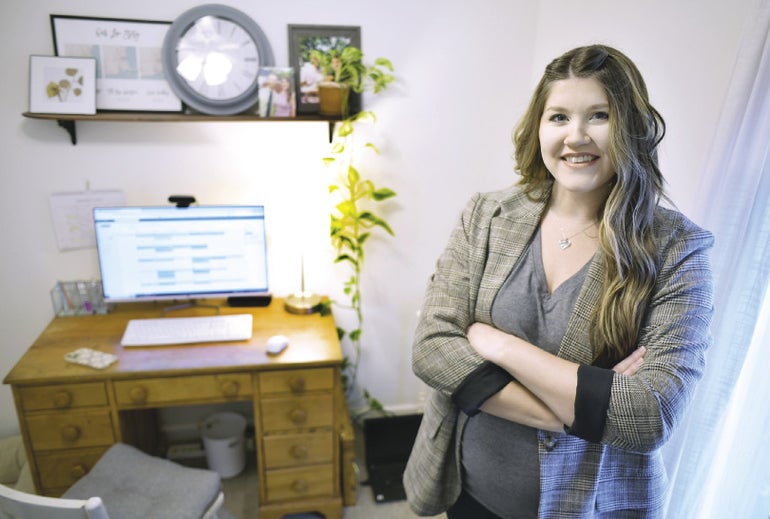
As fewer U.S. employees work remotely, Central Mass. businesses see benefits in the option, particularly for women who often have busier home lives
 Photo | Christine Peterson
Samantha Carr will often work from her home in Spencer for her job at the Center for Women & Enterprise, a policy helping to keep her with the organization, where she advises other female professionals seeking flexibility.
Photo | Christine Peterson
Samantha Carr will often work from her home in Spencer for her job at the Center for Women & Enterprise, a policy helping to keep her with the organization, where she advises other female professionals seeking flexibility.
Samantha Carr and her husband are expecting their first baby soon. Amid all the planning for the new arrival, Carr is grateful there’s one thing she doesn’t have to worry about: returning to a daily commute after her parental leave.
Since it temporarily closed its office in 2020 due to the COVID pandemic, the Center for Women & Enterprise, where Carr works as program manager for the Central Massachusetts office, has allowed her to work a flexible schedule from home.
“Thinking about child care, that’s a lot better for working out how I’m going to do this,” she said. “That’s given me a lot of confidence with starting our family.”
The shift workplaces made to working from home during the pandemic shook up office routines in an unprecedented way. For women workers especially, increased flexibility and remote work options have opened up new possibilities for balancing work and family responsibilities. Today, while certain employers are moving back to the 2019 status quo, others have made lasting changes.

“I’m not seeing anything unified,” said Karen Pelletier, executive vice president of the Worcester Regional Chamber of Commerce. “The key thing that everybody’s doing is being flexible.”
Nationwide, 35% of employees whose jobs can be done remotely were still working exclusively from home in early 2023, according to polling by the Pew Research Center in Washington, D.C.. That’s down from 55% in the fall of 2020 but significantly up from 7% prior to the pandemic.
Changing work-from-home policies

In Central Massachusetts, Pelletier said, a number of companies have instituted policies requiring people to return to working mostly from the office while others have gone in different directions. The Unum Group insurance company is one dramatic example. In 2020, it shut its Worcester office down entirely, moving its 400-plus employees there to remote status.
Others are making choices somewhere in between, with an eye to keeping workers happy.
“Employers are really still struggling to meet their workforce demand for hiring, so they need to be flexible,” Pelletier said.
The law firm Bowditch & Dewey has adopted a hybrid policy for its three offices in Worcester, Framingham, and Boston, said Executive Director Tina Bussone. The firm asks for three days a week in the office from its attorneys and four days from staff. In addition, as one of its benefits, each year every employee can take two remote weeks in a row, and the firm is willing to make exceptions to its on-site policy for special circumstances, like a worker caring for an ailing family member.
Bowditch employees have flexibility about which days to come in, but teams work together to coordinate so all members can be in the office together on the same days. This is helpful for allowing casual water-cooler conversations that can spark ideas and for junior staff who can pop in to a colleague’s door to ask a question, Bussone said.
“If you're a litigator who's in court for a couple of days, you’re probably going to organize your schedule around that,” she said.

Despite all the benefits of in-person contact, Bussone said, Bowditch has learned from its experience during the pandemic that being able to work from home at least some days is valuable to employees. Potential new hires ask about this during interviews.
“Once you have a workforce that is accustomed to a certain level of flexibility, it would be hard to completely take it away,” she said. “If your employees are happy, they’re going to do a better job at work.”
The importance of flexibility for women
The ability to work from home can be especially valuable for women, who often have greater family responsibilities. According to the U.S. Bureau of Labor Statistics, 41% of women employees in the U.S. worked at home for at least part of an average workday in 2022 compared with 28% of men.
Carr sees this play out not just in her own life, but with the clients she works with at Center for Women & Enterprise, many of whom are leaving traditional jobs to start their own businesses. Over the seven years she’s done this work, clients’ motivations have been a mix of excitement about a small business idea and a desire to control their own time. These days, she said, flexibility is an even greater priority.
“It’s more at the forefront than I ever noticed before,” she said.
Meanwhile, CWE’s own shift away from the office has yielded benefits not just for employees but for the organization, Carr said. The group has offices across New England, but prior to the pandemic employees mainly worked with the people in their own office. With the move to remote work, they’ve been making more connections across the region.
“You can foster a great company culture virtually,” Carr said.
Because the CWE Central Massachusetts office now gets less use, it downsized. And, Carr said, she receives frequent inquiries from potential employees who are drawn to the organization by the ability to work remotely.
The shift has cemented her own desire to keep working for CWE.
“It’s been a game changer,” she said. “I’m excited about it because it feels like I have more freedom.”
There’s no one-size-fits-all approach to work routines, Bussone said. Some employees prefer to come in to the office five days a week for face-to-face interactions, or because they like keeping their work and home lives separate. Others find ditching the commute one or two days a week improves their quality of life and gives them more freedom for things like attending their children’s sports events.
“We’re all kind of learning and moving forward in real time,” Bussone said. “Ten years from now, it could be a completely different model; but I sense the flexibility is here and the hybrid way is here to stay to a certain extent.”












0 Comments